Verdict
The Honor 70 is a strong mid-range smartphone, which has an excellent screen and a great main camera. Some consumers might be put off by the fact there’s no IP rating or telephoto sensor, but overall this is still a great phone for the money.
Pros
- Brilliant screen
- Great main camera
- Well-priced
- Appealing design
Cons
- No telephoto camera
- No IP rating
-
Super-specced 6.67-inch OLED screenThis smartphone’s display supports over one billion colours, 100% of the DCI-P3 gamut, and has HDR10+, along with a 120Hz maximum refresh rate -
Triple camera systemOn the rear of this device there are three photographic sensors, with resolutions of 54-megapixels, 50-megapixels, and 2-megapixels -
66W fast-chargingThis handset’s 4800mAh battery is bolstered by 66W fast-charging, which the manufacturer claims can go from 0-60% in just 20 minutes
Introduction
Honor has consistently impressed us in recent months, with particular highlights from the brand being the Honor Magic V, the Honor 50, and the Honor Magic 4 Pro.
This is another phone from the brand which seems to offer plenty of promising specifications, including a feature-packed screen and a high resolution set of cameras.
Is the Honor 70 a mid-range phone that offers enough to tempt you away from costlier alternatives?
Design and Screen
- Attractive rear panel
- Excellent screen
- No IP rating
Honor’s smartphones are usually on the flashy side of things, with some of them even veering towards being garish. However, I feel that the Honor 70 gets the balance pretty much just right with a tastefully mild green colour and a frosted finish which still catches the light rather attractively.
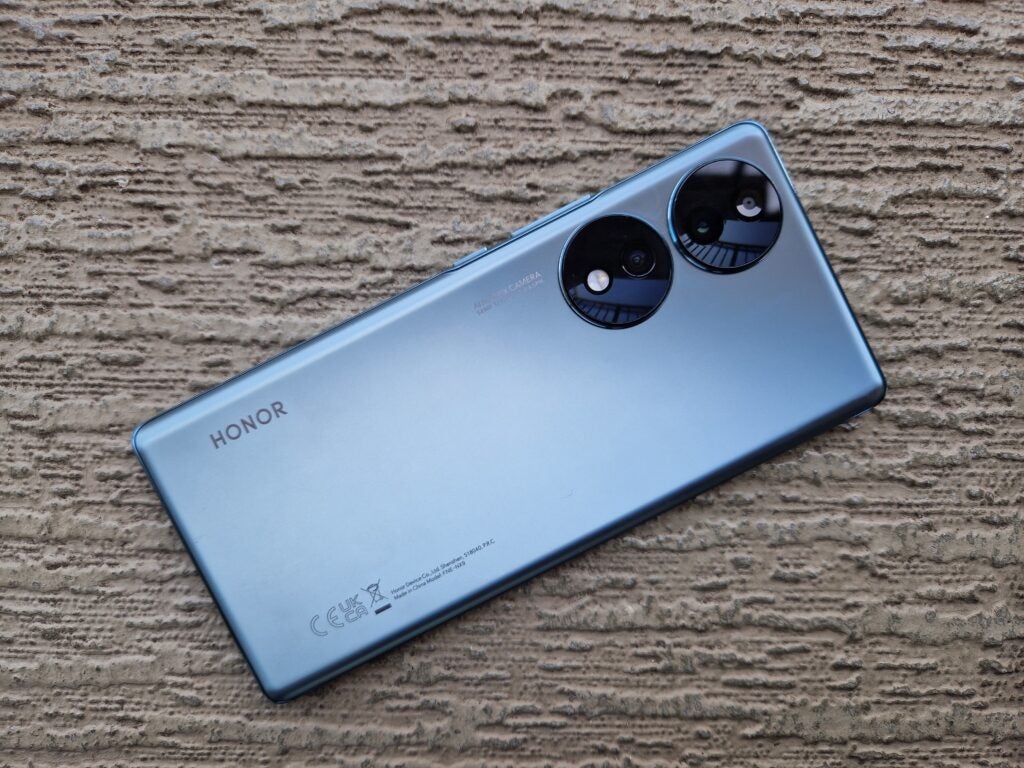
The frosted effect means that smudges don’t show up quite so much as they do on fully glossy surfaces, though it still shimmers pleasingly under the lights for a look that is bound to impress. Three other colour options are available: Midnight Black, Icelandic Frost, and Crystal Silver, the latter of which has a textured finish similar to that of the Huawei P50 Pocket.
The camera sensors are collected in two distinct round modules, which is an interesting and slightly different approach, though you may notice some dust can get collected in the slim gap between the two.
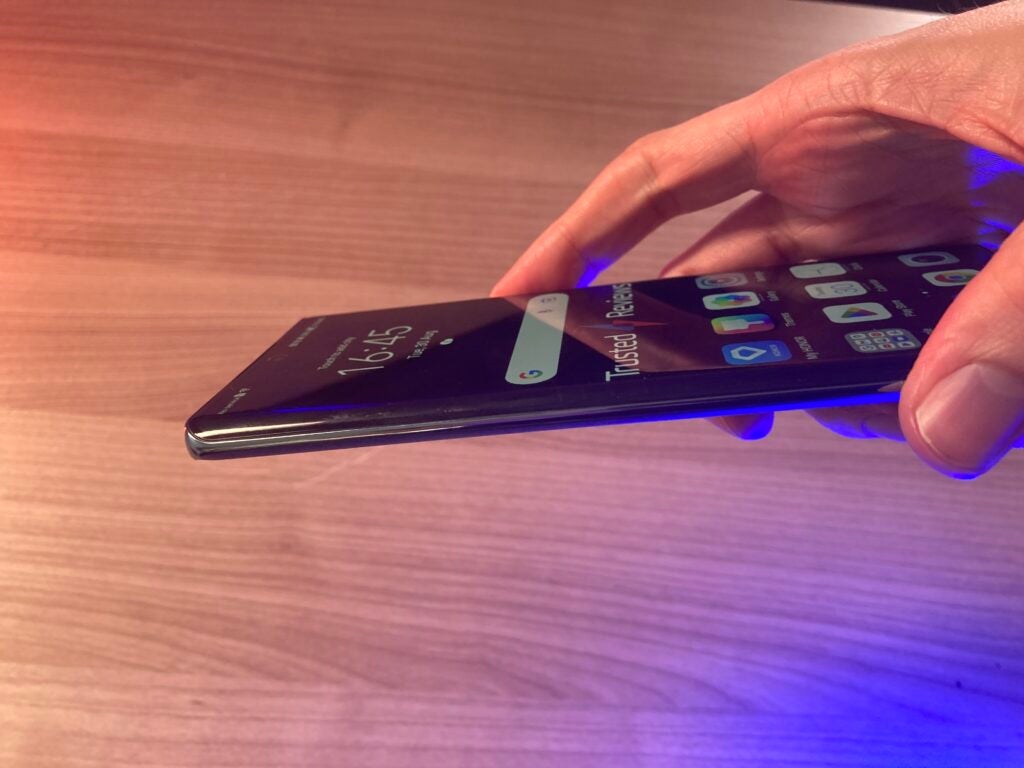
Despite the substantial length of the device (161.4×73.3×7.91mm) it’s actually relatively lightweight for its size, being only 178g. Nonetheless, you may well still find it difficult to use with just one hand due to that large screen; I have fairly long digits but still found it a stretch to reach the top row of apps. Though personally, I prefer a flat screen to one that creeps around the edges like this one, the 58-degree curvature is well-executed here and feels comfortable to hold around the sides.
The device supports dual SIM cards, which is a handy feature, but it doesn’t have an official IP rating so there’s no official pronouncement on what might happen if it’s sprayed with water.
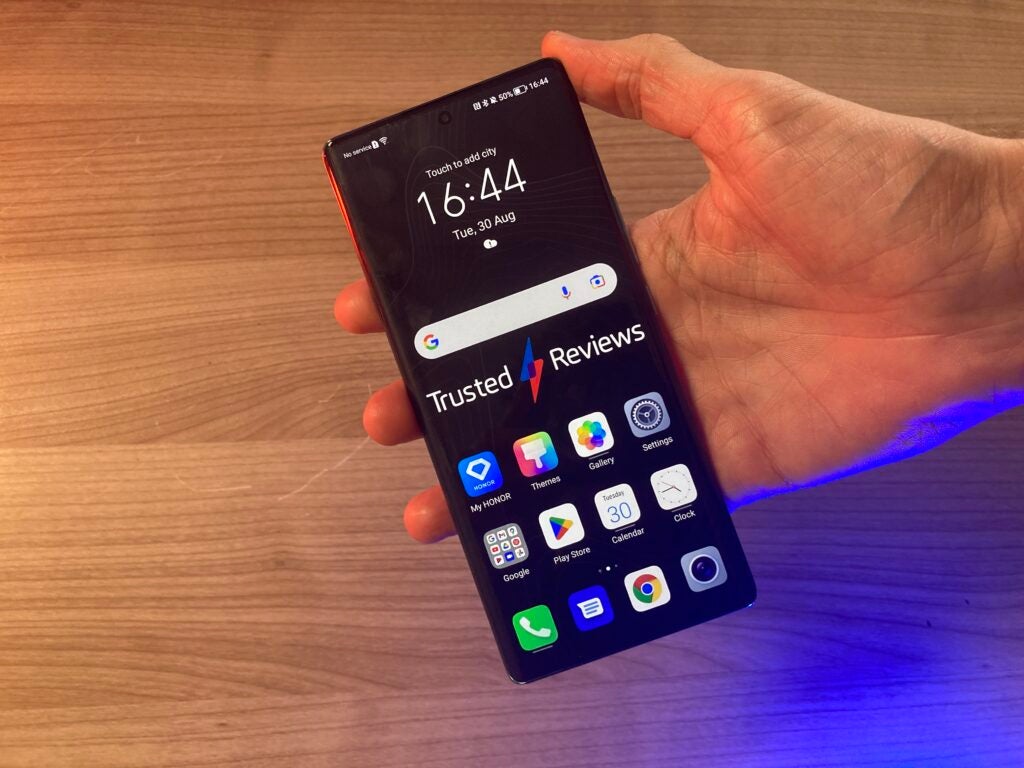
The screen has plenty of specs to impress you with, and I found that these functioned just as well in practice as you’d hope in theory.
Measuring 6.67-inches, and with a 20:9 aspect ratio it’s a large and long screen, and it has a resolution of 2400x1080p which is as sharp as you need it to be. Being an OLED, it has striking contrast levels since the blacks are very pure, so that nicely offsets the display’s support of over 1 billion colours and its HDR10+ too.
This fantastic colour depth and the punchiness of the HDR when you’re watching supported content, really helps you become engrossed in your entertainment. Netflix videos look great, but it was particularly in playing games that I felt really drawn to the screen. Additionally, the phone has a dynamic refresh rate with a maximum of 120Hz, so it’s buttery smooth when you’re scrolling through social media feeds or simply zipping around the operating system.
The only real downside I found to playback here was that there’s just a single speaker at the bottom of the phone, so it didn’t have the enveloping effect offered by stereo speakers (naturally there’s no 3.5mm headphone jack either, so you’ll be best off using Bluetooth headphones with this handset.)
Camera
- Very good overall performance
- No telephoto sensor
Honor has got a good track record with mobile photography, and I’m pleased to say that this has only been burnished with the latest addition to its range of devices.
Housed in those two camera modules on the rear, you’ll find a total of three sensors: one 54-megapixel wide-angle snapper (dubbed a “Sper Sensing Camera” by Honor), a 50-megapixel ultrawide lens with 122-degree field of view that can double up as a macro camera, and a 2-megapixel depth sensor. There’s no telephoto lens for optical zoom, so instead you’ll have to count on digital zoom if you want to get closer to your subject.
Below are three photos taken of the Monument à la République in Paris, all from the same position; the first uses the ultrawide, the second the wide angle camera, and the final one is at 2x digital zoom:



As you can see, there is a decent amount of versatility and the level of detail remains good across the three images, but the main camera is clearly the standout.
Take a look at a few more images I took with just the main camera:




I found the images generally to be both bright and sharp, packing in good levels of detail and colour for appealing photos that do justice to their subjects.
As mentioned, the ultrawide camera has a particularly large 122-degree field of view, and this leads to quite significant distortion. While it’s handy to have an extra lens such as this for a change in perspective, this fish-eye effect is not always desired, and there’s a noticeable step-down in quality more generally as well, with the images being a bit duller and less crisp:

Finally, without a telephoto you’re unlikely to get the high-quality zoom option that you really want when you’re just counting on digital zoom instead, but the Honor 70 still offers fairly good images at the 2x mark (below). If you regularly seek to take close-ups though, you should look for a smartphone that’s stronger in this area, such as the Samsung Galaxy S22 range.

There’s a 32-megapixel selfie camera resting in the holepunch notch at the top of the Honor 70’s screen, and I was fairly pleased with the results I got from this:

The detail was pretty good for hair and skin, and the tones were quite natural-looking as well rather than being too warm or cool.
Overall, the Honor 70 does have some good photographic abilities but these are concentrated in the main sensor. I was particularly expecting more from the ultrawide, but while it’s not on the same level it is at least useful to have in certain situations.
Performance
- Good, though not exceptional, performance standards
- Some pre-installed bloatware
The Honor 70 runs on a Snapdragon 778G Plus chipset, which is built on a 6nm process and finds itself in the upper-end of the mid-range spectrum. For gaming performance, this is buttressed with an Adreno 642L GPU and Honor’s GPU Turbo X tech.
The performance appeared very strong to me as I used the smartphone for a variety of different purposes, from shooting with the camera to playing mobile games, to running social media apps and more, while multitasking between these different tasks always came off without a hitch.
This good performance was reflected in benchmark scores, shown below; however, it was still outstripped by several similarly-priced peers in both CPU tests (measured by Geekbench 5) and GPU tests (measured by 3DMark). If the highest possible performance, especially for gaming, is high on your list of priorities then you could consider some alternatives such as the recently-launched Oppo Reno 8 Pro, but I never felt let down by this handset in my experience.
In addition to the good performance, there’s also support for 5G and Wi-Fi 6 here, along with NFC and Bluetooth 5.2, so connectivity is strong all round.
The Honor 70 runs the Android 12 operating system, and it’s got the full suite of Google Mobile Services on board; ever since the brand’s separation from previous parent company Huawei, it has no longer been hit by US restrictions on that front.
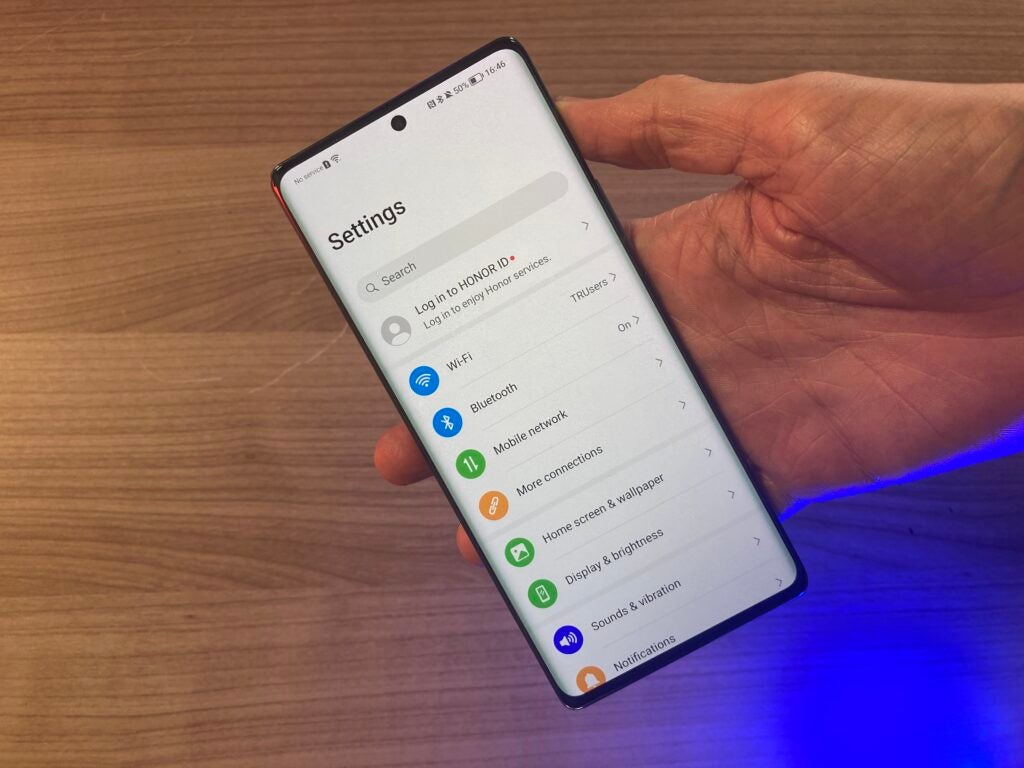
Overlaid on Android 12 is the Magic UI 6.1 interface. By default it opts not to have an app drawer in favour of a multi-page home screen, and there are quite a few pre-installed apps present here on start-up. From a couple of games to TikTok, Facebook, and several travel agent apps, I could have happily done without these.
Magic UI 6.1 also features a floating window feature than can be accessed by swiping and holding on the screen from either the left or the right, and this can bring up a few apps in a secondary window so that you can multi-task. I found this to be quite handy, especially for taking notes, though it’s not a gamechanger because it’s not terribly strenuous to just flick between fully open apps when multitasking.
Battery Life
- Decent though not brilliant battery
- 80W fast-charging support
The battery capacity on the Honor 70 is 4800mAh, which is a good size considering that the handset is relatively thin and lightweight.
In my experience, the battery life was good, though it’s not one of the phone’s strongest points. To give a few real-life examples, I found that one hour of watching Netflix knocked 6% off the battery, half an hour of intensive gaming saw me lose 8%, and one hour of streaming music online sapped 3%.
These scores are average for a modern smartphone, and I found that the Honor 70 could reliably get me through a day’s usage. When left on standby overnight, it only lost 5% of its capacity.
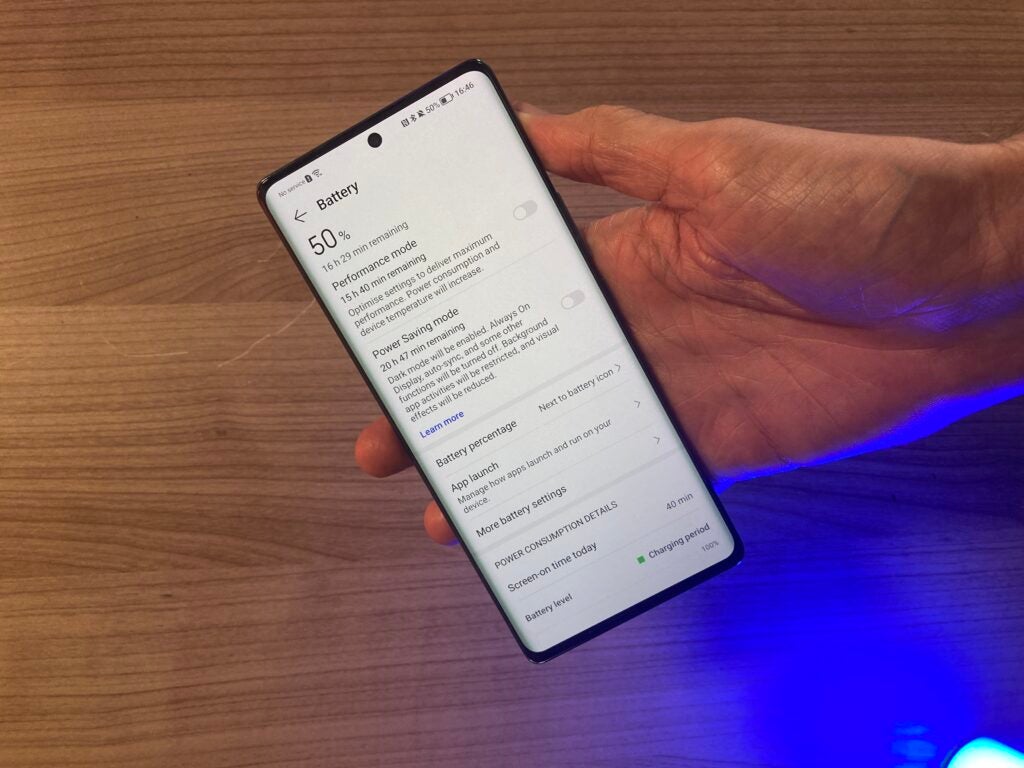
The Honor 70 is supported by 66W fast-charging, with the charger included in the box, and the manufacturer claims that this will see you go from 3% to 60% in just 20 minutes. Those are excellent results, and this feature is a really handy one especially when you’re looking to get a quick top-up before heading out of the house or the office for a few hours more.
However, the sample we received was packaged with an EU charger rather than a UK one, so I wasn’t able to verify these claims exactly. When using a fast-charger from a different brand, the charging had evidently been capped at a much slower speed than the model’s maximum capability since it took over an hour to reach 50%.
While the claimed fast-charging speeds are impressive, they are just limited to wired charging; wireless charging isn’t a possibility on this phone, so that’s a potential pain point if you find it more convenient to juice up your handset in this way.
Should you buy it?
If you’re looking for a strong all-rounder at a mid-range price point, then you really can’t go far wrong with this one.
If you’re not willing to overlook a couple of compromises, such as the lack of a telephoto sensor or IP rating, then you might want to shell out for a flagship instead.
Final Thoughts
The Honor 70 is a very strong all-round package, delivering in spades in all of the most important areas. The screen is wonderful for playing games or watching videos, being both smooth and punchy, while the camera is highly detailed and produces very pleasing images. Performance is plenty strong enough by my reckoning, though not exceptional in its field, and the battery is good enough to get you through the day.
You might be a little disappointed in the lack of an IP rating, or the lack of a dedicated telephoto sensor for that matter, and it’s true that these would be notable improvements; however, it’s inevitable that there will some compromises in a mid-range device, and you’re unlikely to find alternatives that are as good as the Honor 70 for the same price.
FAQs
Yes, you can get 5G with this phone as long as you’ve got a compatible SIM card and network coverage.
It comes in four different colours: Midnight Black, Emerald Green (as shown in the review), Icelandic Frost, and Crystal Silver.
No, it doesn’t have an official IP rating so there’s not an objective certification on how it might deal with being exposed to water or dust.
Sustainability
Trusted Reviews holds the fact that global warming is not a myth as a core value and will continuously endeavor to help protect our planet from harm in its business practices.
As part of this mission, whenever we review a product we send the company a series of questions to help us gauge and make transparent the impact the device has on the environment.
We currently haven’t received answers to the questions on this product, but will update this page the moment we do. You can see a detailed breakdown of the questions we ask and why in our sustainability info page.
Jargon buster
IP rating
An abbreviation for ‘Ingress Protection Code’, which lets you know to what extent a device might be waterproof or dustproof.
OLED
Organic Light Emitting Diode is panel technology that allows each individual pixel to produce light rather than relying on a backlight. This enables the screen to accurately display blacks by turning off the pixel, resulting in improved contrast compared to conventional LCD panels.
HDR10+
HDR10+ is a HDR format supported by Panasonic and Samsung as a free to use, open platform alternative to Dolby Vision. It adds dynamic metadata on top of the core HDR10 signal that tells a TV how it should adjust the brightness, colours and contrast of content for the most optimal picture quality.
Variable Refresh Rates
Variable Refresh Rate enable a game console/PC to send video frames as quick as possible to a display, with the screen adapting its own refresh rate in real-time to match the source, reducing visual artefacts and offering a more responsive performance
















